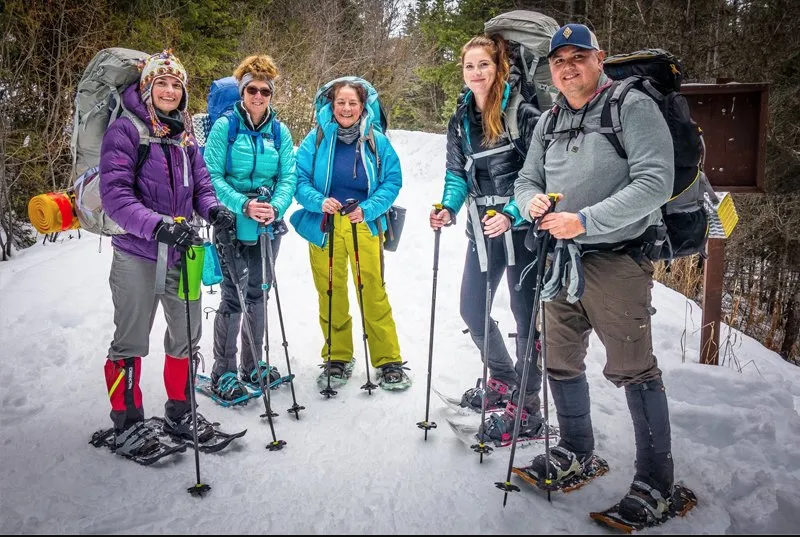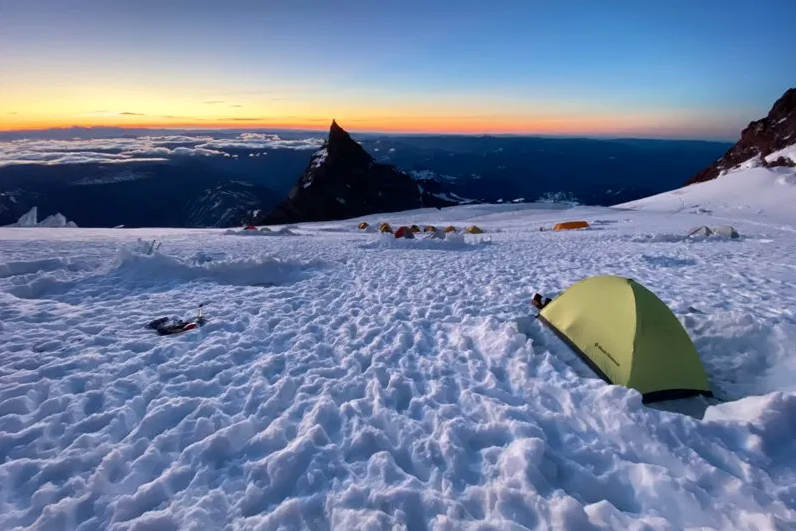MIYAR ADVENTURES BLOG // Guide to Winter Camping & Gear
Snowshoers setting out on a winter camping trip
We often think of the arrival of winter weather as the end of camping season. But there’s no reason to let snow keep you indoors! With the proper preparation and gear, winter camping can open up a wonderland of possibilities in the backcountry for adventures by ski, splitboard, or snowshoe. Winter camping means planning ahead to cope with cold temperatures and paying close attention to both weather and avalanche forecasts, but with the right preparation it also means that the quiet hush of a pristine, beautiful forest in snowy solitude will be yours!
“There’s no such thing as bad weather, only unsuitable clothing” – Alfred Wainwright. Coast to Coast, 1973.
Want to learn the skills needed to go snow camping? Join us for a guided Cold Weather Snow Camping trip and receive hands-on experience winter camping in mountainous terrain with one of our expert guides. You’ll learn the essentials of what to pack and what to wear, how to navigate in the snow, how to choose and make a camp, and how to cook in a cold-weather kitchen. Read on for some of the basics!
Winter Camping Gear
The most important thing to guarantee your success snow camping is making sure you have the right equipment and supplies. In addition to the Ten Essentials, you’ll want to pack the following:
To get you there, you’ll want snowsports equipment like skis, a splitboard, or snowshoes. Your footwear should be warm and waterproof — now is NOT the time to get cold feet! If you’re venturing anywhere near avalanche terrain, be sure to carry avalanche safety equipment like a beacon, probe and shovel. An Avy pack with an airbag can also be a great addition when traveling in avy terrain.
Layers are essential to help keep yourself the right temperature, especially warm base layers. Avoid anything made from cotton, as it does not wick moisture and takes a long time to dry, wasting essential heat. Wool and synthetic base layers are vital, as are a warm jacket and warm wool socks. Bring a surplus of hand warmers and insole warmers to preheat your boots in the morning and keep your hands toasty whenever they cool down.
Your camp kitchen should be stocked with extra food (calories = warmth!) and with options for hot beverages to inspire fluid intake. Try tea, hot chocolate, and coffee. Selecting a camp stove that is both fuel-efficient and wind-resistant will keep you fed quickly and without frustration. If you need to melt ice for drinking water in the shortage of other options, a reliable stove makes all the difference. Additionally, insulating your fuel canisters may make for happier campers. Cold fuel can be a challenge to light.
Finally, to make camp, you’ll need an all-weather or four-season tent that can stand up to the elements and a set of snow stakes to stake it out. Next, a winter-ready sleeping bag that is rated for temperatures below what you expect to camp in will make sure that you can safely stay the night. A thick sleeping pad or double pads for extra ground insulation will also help with warmth. Now, on to our snow camping tips!
Snowy camping above the clouds on an ascent
Setting Up Your Tent In The Snow
The key to setting up your tent in the snow is taking the time to scope an ideal campsite. Look for somewhere sheltered from the wind and away from avalanche danger. Avoid hazard trees or tree wells. Pick a site with sunrise exposure, if possible. Having that early sun on your tent will help you wake up and warm up in the morning. Most importantly, pack the snow beneath your tent so it is firm and flat and ensure your snow stakes are secure.
How To Keep Your Tent Warm In Winter
Besides finding a campsite with sunrise exposure, there are plenty of ways to keep warm while snow camping. First, and most importantly, pack a temperature-rated sleeping bag and pad, along with plenty of layers. Warm, dry ground insulation is key to keeping yourself cozy at night. Double up on sleeping pads if you can. Layering one inflatable sleeping pad with a high R-value on top of a closed-cell foam pad is a great system for cold temperatures. Exercise before getting into bed to raise your core temperature, but don’t sweat in your clothes too much! Dry layers are ideal for keeping warm through the night. You can also make a hot water bottle using a camp stove to heat water which you can then pour into any watertight container to warm your bed.
Winter Camping Tips
The most important tips for winter camping are similar to those for camping year-round, but even more vital as the stakes are higher when the temperature dips lower.
Safety first: Check the forecast first and never travel in unsafe conditions. Make sure you and your group members have the training to react in an emergency. Crevasse rescue, avalanche safety courses, and wilderness first-aid courses can give you the assurance you need to relax and enjoy the backcountry. Pack your first aid, avy gear, and emergency supplies. Always tell a friend or family member your destination and estimated return date.
Stay warm: Not just important for you, but for your gear as well! Electronics may fail when batteries get too cold, so charge the batteries well and keep them warm with your body heat. If your gear gets wet, you can use your body as a heater and dryer — put damp socks in your sleeping bag to help them dry off by morning. Keeping your boots IN the tent, instead of outside/in a vestibule, can help keep them toasty as well.
Eat and drink: Calories equal heat, and your body will need extra calories to stay warm. This means loading up on food and drinks whenever you can. If it’s cold enough, your water may freeze during nighttime storage. Ice floats, so store your bottled water upside down to prevent the mouth of the bottle from freezing. It’s easy to forget to drink water when it’s not hot outside. Stay hydrated!
Wrapping It Up
If you prepare for it properly, camping in the snow can be one of the most extraordinary adventures of your lifetime, and with this list you should have everything you need to enjoy your trip. Check your gear before you go, and stay warm and safe out there! Contact us to set up a Cold-Weather Snow Camping trip with one of our guides today or stop into our sister shop in Ballard, Ascent Outdoors, to speak with a professional about your packing list.

